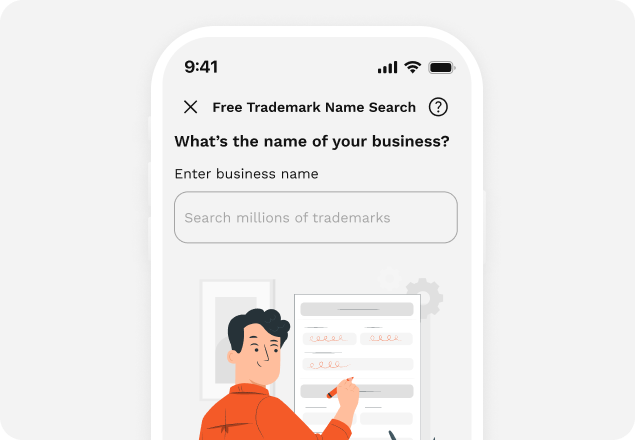
Complete our straightforward questionnaire to initiate the registration process. Most users finish in as little as 7 minutes.
We'll craft the official application for you and provide it online for your review and approval.
Once you upload or send us your work, we'll proceed to file your copyright application with the U.S. Copyright Office.

Trademarks identify your products and services as distinctly belonging to your brand, distinguishing you from competitors. You can register a trademark for different types of intellectual property including your business name, product name, tagline, logo, symbol, or design. A registered trademark must be used in commerce to provide real protection against anyone who wants to copy you. Registering a trademark can be a complicated process, but attorneys can walk you through the steps and file your application.
A trademark means that a business name, brand name, tagline, logo, symbol, or design is registered with the USPTO, and that its use by others is restricted. Registering a trademark is a legal process of providing protection against competitors who want to copy your branding.
of your federal copyright application, including a review by our copyright team for accuracy, completeness, and common mistakes.
Your application will be electronically filed with the U.S. Copyright Office, eliminating the need to wait for mail or deal with paper files.
Receive your certificate directly from the U.S. Copyright Office.
Receive a customer-specific form that you can further customize if someone is infringing on your copyright.
Access a custom assignment template. If you need to sell or otherwise convey your copyright, you can utilize this pre-filled template that is also customizable.
Enjoy expedited processing of your copyright application, with preparation completed within 24 hours. Normal processing time is 5 business days in our Basic package.

We make connecting with a professional straightforward, so you can take care of business easily and efficiently.

Get your questions answered by our team of tax professionals or independent network of attorneys.

Get unlimited calls on new topics for a monthly cost that’s less than an hour with an attorney from a traditional firm.*
While copyrights and registered trademarks both help protect your intellectual property, they are used for different things.
Get the comprehensive tools you need to run and grow your business with confidence.

Feel confident in your creative pursuits, assured that your work is shielded against unauthorized use.

Obtain official documentation affirming your exclusive ownership of your work, granting you the authority to extend those rights to others.

Establish yourself as the rightful copyright owner, equipping yourself with the legal recourse to take action against any unauthorized usage of your work.
Federal Mark Pro has secured a whopping 4.5 out of 5 stars, as per 31,500 reviews.

120
K+Trademark registrations
3500
+Copyright registrations
Nearly
Trademark Renewals

Get the comprehensive tools you need to run and grow your business with confidence.
In the United States, the law grants you a copyright in your work the moment you create it, irrespective of whether you register it. As long as your work is original and displays a basic level of creativity, you may assert ownership and seek protection. However, without registration, your protection is limited; you cannot enforce your rights in a court of law in the United States.
A trademark typically safeguards a word, phrase, symbol, and/or design that identifies the source of goods—what we recognize as brand name and brand recognition. On the other hand, a patent usually protects an invention, encompassing its functionality or design. In legal terms, a patent covers "any new and useful process, machine, manufacture, or composition of matter, or any new and useful improvement thereof" (35 U.S.C. § 101). Patents typically grant the owner exclusive rights to manufacture products or use processes covered by the patent for 20 years from the earliest priority date. In contrast, a trademark, if properly maintained, can endure indefinitely.
Copyrights, meanwhile, primarily shield artistic works such as books, photographs, art, movies, and music.
Ability to File Lawsuit: Registration enables you to file a lawsuit for copyright infringement. Without registration, you lack the legal standing to bring a lawsuit.
Statutory Damages: Registered works are eligible for statutory damages in copyright infringement cases. This means you can seek predetermined damages without having to prove actual harm caused by the infringement.
Protection from Imported Infringing Copies: Registration allows you to record the copyright with the U.S. Customs Service, providing protection against the importation of infringing copies.
Firm Claim of Ownership: Registration serves as a public record of your copyright claim, making it harder for infringers to argue ignorance of your ownership.
Image of Establishment: In certain industries, such as film scripts, copyright registration may enhance your credibility and professionalism, potentially influencing how others perceive you and your work.
There are various categories, also known as International Classes, available to identify specific goods or services. The USPTO offers a predetermined list of trademark categories to choose from. It might be beneficial to register a mark within multiple classes, such as registering a company name and also for the ability to sell merchandise with the company name on it. Keep in mind that there is a USPTO filing fee for each selected category.
Before selecting a category, it's essential to determine if you are selling a good or providing a service. Goods typically refer to physical items like nuts, bolts, beer, and t-shirts, while services encompass specific activities like legal, consulting, or accounting services. In some cases, registering under multiple classes may be advantageous.
The selection is critical because a registered trademark usually protects only the category listed in the application. Broader categories may offer more extensive protection, but if the category does not accurately match the applied-for good or service, the registration could be invalidated. Additionally, changing the class designation can be challenging and may require an additional filing fee.
It's important to note that a company name and specific product names may each be trademarked separately and may involve different categories. Each registration would necessitate payment of additional fees to the USPTO and to the Federalmark Pro.
Determine whether you are selling a good or providing a service.
Strive for accuracy, as filing in the wrong class could lead to rejection by the USPTO.
Choose the most suitable category from the USPTO list, available on the drop-down menu on the Federalmark Pro website.
Review the published information about categories included in the Federalmark Pro's User's Manual for more details on possible categories.
Focus on the finished product or service delivered to consumers rather than the ingredients or components.
Consider what is actually sold to consumers and exclude additional items like employee apparel featuring the company logo.
Do not consider packaging when selecting a category. For example, a fruit seller does not sell paper goods just because their logo appears on the packaging.
Although more costly, some companies file under multiple categories when selling multiple products.
In most cases, a copyright lasts for the life of the author plus 70 years. For example, if the author of a work passed away in 2070, the copyright would typically last until 2140.
For works made for hire, anonymous works, and pseudonymous works, the duration of copyright is 95 years from publication or 120 years from creation, whichever is shorter.
Reach out to us today to safeguard your intellectual property.
Reach out to us today to safeguard your intellectual property.